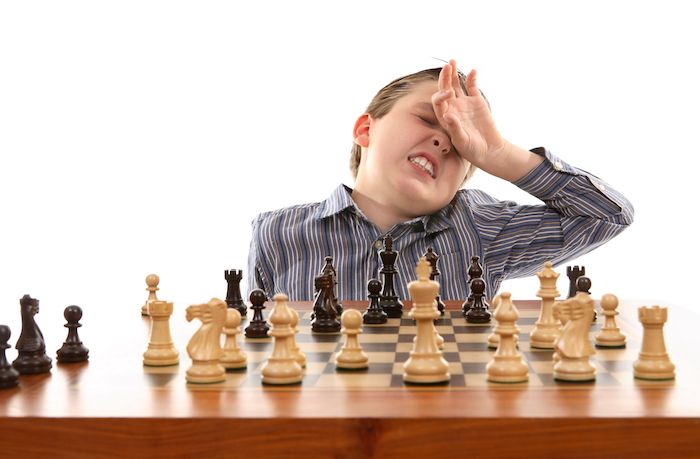
7 Dumb Chess Ideas To Avoid This Year
We've kicked off a new year, but beginning chess players still play the same unsound chess ideas that have been tried by inexperienced players for decades.
Unless their opponents are similarly new to the game, players relying on these unsophisticated tactics usually will not score a win from them.
To succeed at chess, it takes a lot more than learning a few tricks and hoping your opponent will fall for them.
Similarly, it is much more productive for amateur players to learn the well-established principles of chess rather than trying to reinvent the wheel with their own ideas (often with hilarious results).
Not only do these oft-tried ideas rarely work to win the game -- they also lead to losing positions.
You don't have to be Hikaru Nakamura or Magnus Carlsen to counter these ideas. As you will see below, even a chess player as mediocre as me can refute these dumb strategies -- unless I am making the same errors myself!
Before starting this article, I played a few games against lower-rated players to see if these same ideas still came up...and they sure did.
Let us know in the comments and on Facebook some of the bad chess ideas you will avoid in the new year.

1. Opening with rook pawns

Maybe it's something to do with learning to read from left to right, or starting a list from the beginning. But for whatever reason, a total beginner often opens the game with 1. a4 -- a horrible move.
Sometimes they will follow that up with 2. h4, which is another bad idea.
You see this misguided opening attempt from beginners even after they have a few games under their belts, maybe because the rook is a nice and easy piece to understand and they want to start using it immediately.
Better idea:
Open with your central pawns instead. This time-tested idea controls vital territory in the center and opens up diagonals to develop your bishops and queen.
2. Trying for scholar’s mate

image via Zazzle
Many beginning chess players no doubt scored their first checkmates with this simple sequence:
The queen can also try her attack from h5 instead of f3 -- it makes no difference.
After achieving exciting checkmates with this setup, many players make it a permanent part of their opening repertoire.
The problem, though, is that scholar's mate is trivially easy to defend, and after it is defended, the attacking side's pieces are misplaced and its position is under-developed.
Sometimes the attempt at scholar's mate will be a little more sophisticated, but the fact remains that the queen is still not on a good square.
Better idea:
Develop your knights and bishops to good squares before your queen. Focus on controlling space, important squares, and open lines before launching any attack.
3. Moving knights to the rim

Many beginners like the fact that the knight can jump over pieces, and they like moving it out early in the opening. That's all well and good -- you should develop your knights quickly in most openings.
But often, beginners will inexplicably move their knights to the edge of the board instead of the correct move toward the center.
Maybe they think: "Nf3, Nh3, what's the difference?"
The difference is that the knight is far more immobile from the edge of the board, and controls fewer important squares from there, too.
Better idea:
Develop your knights properly toward the center of the board. Only move your knights to the edge of the board for a specific purpose.
4. Giving up the right to castle

Castling is the only move in chess where you can move two pieces at once. It safely tucks your king away from the dangerous center, and activates a dormant rook.
So why would you want to give up the right to make this useful move?
Beginners do it all the time, perhaps not aware of how crucial castling is to get a playable position -- or perhaps not aware that castling exists at all!
Sometimes you have to look a few moves ahead to avoid a trade of pawns that will prevent you from castling.
Better idea:
Unless you're Hikaru Nakamura, who castled just 22 times in the 33 games of his amazing Death Match win, it's probably a good idea to plan to castle almost every game.
5. Assuming re-captures and missing in-between moves

It's foolish to assume that your opponent must make the move you're relying on. Often this misguided assumption includes an immediate re-capture that is in fact delayed or ignored completely for a better move.
I fell victim to this one in the dumbest possible way. After building an easy winning position, I dropped an exchange, subconsciously assuming my opponent would re-capture my bishop instead of the rook I just left undefended.
Looking back, I also think I forgot that once my bishop moved away to capture his bishop, it would no longer be guarding my rook.
GM Serper wrote about a similar -- albeit much more complex -- chess illusion that grandmasters miss.
Even world champions like Magnus Carlsen and Vishy Anand overlook in-between moves. In my Best Chess of 2014 article, I highlighted Carlsen's blunder and Anand missing the winning in-between move -- see if you can spot it:
Better idea:
Double-check your calculations before any forcing sequence. Don't assume your opponent MUST re-capture a pawn or piece unless it's his or her only legal move.
Sharpen your general tactical awareness in our free tactics trainer, or try your hand at our daily tactics puzzle on Facebook:
6. Neglecting your back rank

In the excitement to win material, beginning players often overlook their most important piece: the king.
Entombed by his own guarding phalanx of pawns on the first row, a simple rook or queen check ends the game.
Experienced players rarely miss a one-move back rank mate, but beginners fall for it all the time.
Better idea:
Before moving any piece off your back rank, make sure your opponent doesn't have a devastating check. Watch out for newly opened files that might lead to your back rank.
You can also make an escape square for your king to flee on, but try not to weaken his castle too much.
7. Getting greedy

Like the stereotype in the picture above, when you get greedy in chess you are setting your chances to win aflame.
Grabbing pawns deep in the enemy camp is a risky proposition, especially in the opening when the rest of your army is at home. Even if you succeed in getting an extra pawn or two, your development deficit might be too much to overcome.
Beginners often use the queen when they get greedy, which is as dangerous as it gets. Not only are they neglecting the rest of their pieces to move the queen several times in the opening -- they are also at risk for their most powerful piece to get trapped and lost.
Better idea:
Material is important, but greed is definitely not good in chess. Focus on mobilizing all your forces and getting your king to safety before you go shopping for stray pawns. Even then, beware of traps -- sometimes those pawns are not free after all.
What are some dumb chess ideas you want to avoid in 2015? Let us know in the comments.
GET THE MOST OUT OF CHESS.COM
- Read Pete's previous article: The Best Chess of 2014.
- Watch GM Gregory Kaidanov's video on in-between moves.
- Check out some of our fun video lectures: IM Rensch and GM Finegold are two of our most popular authors.
- Have fun and learn at the same time with the Tactics Trainer.
- Looking for articles with deeper analysis? Try our magazine: The Master's Bulletin.







